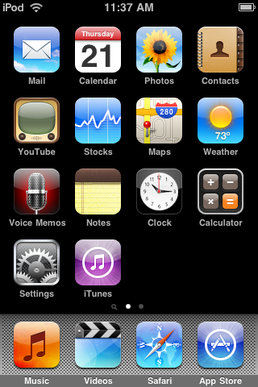| Version of the iOS operating system | |
 | |
 iPhone OS 3.1.3 default home screen layout on an iPod Touch (2nd generation) | |
| Developer | Apple Inc. |
|---|---|
| Source model | Closed, with open source components |
| Initial release | June 17, 2009 |
| Latest release | 3.2.2 (7B500) / August 11, 2010 |
| Update method | iTunes through a computer |
| Package manager | App Store |
| Platforms | |
| Kernel type | Hybrid (XNU) |
| License | Proprietary software except for open-source components |
| Preceded by | iPhone OS 2 |
| Succeeded by | iOS 4 |
| Official website | Apple - iPhone - New features in the iPhone 3.0 Software Update at the Wayback Machine (archived August 18, 2009) |
| Support status | |
| Obsolete, unsupported[citation needed] | |
iPhone OS 3 (stylized as iPhone OS 3.0) is the third major release of the iOS mobile operating system developed by Apple Inc., succeeding iPhone OS 2. It was announced on March 17, 2009, and was released on June 17, 2009. It was succeeded by iOS 4 on June 21, 2010, dropping the "iPhone OS" naming convention.[1]
iPhone OS 3 added a system-wide "cut, copy, and paste" feature, allowing users to more easily move content. It also introduced Spotlight, a search indexing feature designed to help users locate specific information on their device, such as contacts, email messages or apps. The home screen was expanded to let users add up to 11 pages, showcasing a total of 180 apps. The Messages app received support for MMS, while the Camera app received support for video recording on the iPhone 3GS, and a new "Voice Memos" app let users record their voice. In-app purchase capability was added to third-party applications as well.
iPhone OS 3 is the last version of iOS that supports the first-generation iPhone and first-generation iPod Touch as its successor, iOS 4, drops support for both models.
- ^ Patel, Nilay (June 7, 2010). "iPhone OS 4 renamed iOS 4, launching June 21 with 1500 new features". Engadget. AOL. Archived from the original on June 14, 2017. Retrieved July 20, 2017.